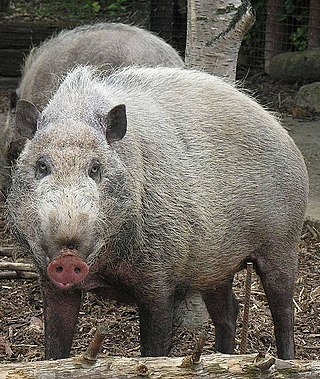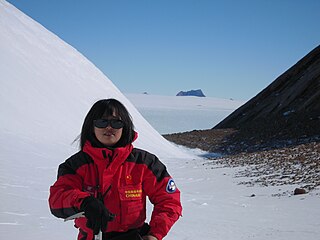This article contains content that is written like an advertisement .(March 2020) |
The Wuzhishan pig is a breed of inbred miniature pig created by Professor Feng Shutang [1] intended to be used as a model organism for medical research.
This article contains content that is written like an advertisement .(March 2020) |
The Wuzhishan pig is a breed of inbred miniature pig created by Professor Feng Shutang [1] intended to be used as a model organism for medical research.
A Wuzhishan pig’s length ranges from 50 to 70 cm long (19.7-27.5 inches), with adults typically weighing between 30 and 35 kilograms (66.1-77.2 pounds). [2] They have a distinctive two-toned body which is black dorsally and pink ventrally.
The Wuzhishan pig is mainly used to study the human circulatory system due to the similarities between pig and human organs. [3] [2]
The full genome sequence and analysis were completed by BGI Group in 2012; the breed was successfully identified in early 2013. [4] The intellectual property rights for the breed are protected by both Chinese [5] and American patents. [6]
On May 18 2015, the Chinese Academy of Agricultural Sciences announced that its Institute of Animal Science agreed to transfer all breeding research to Beijing Grand Life Science & Technology Co., Ltd., [7] which had the sole rights to breed and sell Wuzhishan pigs for commercial purposes.
Multiple Chinese research institutions, medical schools, hospitals, and enterprises conduct research around Wuzhishan pigs to establish their suitability as research models. [8] [9] Research on future life science and medical applications of the pigs also began to take place, to which the initial results include the injection of embryonic germ cells into blastocysts, [10] along with islet isolation and purification. [11]
On June 23, 2017, the Academy of Military Medical Sciences and Grand Life Science declared that the PERV-pol gene-deficient Wuzhishan pig had been identified and verified by systematic virology methods and whole genome sequencing. [12] Grand Life had succeeded in reproducing F0/F1 PERV-noninfectious Wuzhishan pigs that then became available for advanced biomedical research purposes, [13] including a series of studies under the 2017-2020 National Primary Research Programs on bio-material development and tissue-organ repair.

Sus is the genus of wild and domestic pigs, within the even-toed ungulate family Suidae. Sus include domestic pigs and their ancestor, the common Eurasian wild boar, along with other species. Sus species, like all suids, are native to the Eurasian and African continents, ranging from Europe to the Pacific islands. Suids other than the pig are the babirusa of Indonesia, the pygmy hog of South Asia, the warthogs of Africa, and other pig genera from Africa. The suids are a sister clade to peccaries.

The guinea pig or domestic guinea pig, also known as the cavy or domestic cavy, is a species of rodent belonging to the genus Cavia in the family Caviidae. Breeders tend to use the name "cavy" for the animal, but "guinea pig" is more commonly used in scientific and laboratory contexts. Despite their name, guinea pigs are not native to Guinea, nor are they closely related to pigs. They originated in the Andes region of South America. Studies based on biochemistry and hybridization suggest they are domesticated animals that do not exist naturally in the wild, descendants of a closely related cavy species such as C. tschudii. They were originally domesticated as livestock for a source of meat, and are still consumed in some parts of the world.

Xenotransplantation, or heterologous transplant, is the transplantation of living cells, tissues or organs from one species to another. Such cells, tissues or organs are called xenografts or xenotransplants. It is contrasted with allotransplantation, syngeneic transplantation or isotransplantation and autotransplantation. Xenotransplantation is an artificial method of creating an animal-human chimera, that is, a human with a subset of animal cells. In contrast, an individual where each cell contains genetic material from a human and an animal is called a human–animal hybrid.

The laboratory mouse or lab mouse is a small mammal of the order Rodentia which is bred and used for scientific research or feeders for certain pets. Laboratory mice are usually of the species Mus musculus. They are the most commonly used mammalian research model and are used for research in genetics, physiology, psychology, medicine and other scientific disciplines. Mice belong to the Euarchontoglires clade, which includes humans. This close relationship, the associated high homology with humans, their ease of maintenance and handling, and their high reproduction rate, make mice particularly suitable models for human-oriented research. The laboratory mouse genome has been sequenced and many mouse genes have human homologues. Lab mice are sold at pet stores for snake food and can also be kept as pets.

The Leizhou Peninsula, alternately romanized as the Luichow Peninsula, is a peninsula in the southernmost part of Guangdong province in South China. As of 2015, the population of the peninsula was 5,694,245. The largest city by population and area on the peninsula, was Zhanjiang.

The pig, also called swine or hog, is an omnivorous, domesticated, even-toed, hoofed mammal. It is named the domestic pig when distinguishing it from other members of the genus Sus. It is considered a subspecies of Sus scrofa by some authorities, but as a distinct species by others. Pigs were domesticated in the Neolithic, both in East Asia and in the Near East. When domesticated pigs arrived in Europe, they extensively interbred with wild boar but retained their domesticated features.
A transgene is a gene that has been transferred naturally, or by any of a number of genetic engineering techniques, from one organism to another. The introduction of a transgene, in a process known as transgenesis, has the potential to change the phenotype of an organism. Transgene describes a segment of DNA containing a gene sequence that has been isolated from one organism and is introduced into a different organism. This non-native segment of DNA may either retain the ability to produce RNA or protein in the transgenic organism or alter the normal function of the transgenic organism's genetic code. In general, the DNA is incorporated into the organism's germ line. For example, in higher vertebrates this can be accomplished by injecting the foreign DNA into the nucleus of a fertilized ovum. This technique is routinely used to introduce human disease genes or other genes of interest into strains of laboratory mice to study the function or pathology involved with that particular gene.

The University of the Chinese Academy of Sciences is a public university headquartered in Shijingshan, Beijing, China. It is affiliated with the Chinese Academy of Sciences. The university is part of the Double First-Class Construction. Officially established in 2012, the university derives from the Graduate School of the University of Science and Technology of China founded in 1978.

Genetically modified animals are animals that have been genetically modified for a variety of purposes including producing drugs, enhancing yields, increasing resistance to disease, etc. The vast majority of genetically modified animals are at the research stage while the number close to entering the market remains small.

Miniature pigs, also called mini pig are small breeds of domestic pig.

The Meishan is a breed of domestic pig named for Meishan, Jiangsu Province. It is a sub-group of the Taihu pig and is a small to medium-sized breed with large drooping ears, and wrinkled black skin. Meishan Pigs are extremely docile and renowned for their tender and flavorful red meat pork.

Genetically modified mammals are mammals that have been genetically engineered. They are an important category of genetically modified organisms. The majority of research involving genetically modified mammals involves mice with attempts to produce knockout animals in other mammalian species limited by the inability to derive and stably culture embryonic stem cells.

The Taihu pig is a domestic breed of pig from the narrow region of mild sub-tropical climate around the Lake Tai region in the lower Yangtze River Valley of China. The breed is a large one, black in colour with a heavily wrinkled face. It has a large head with a broad forehead and large folded ears. The breed has a number of divisions, classified by some authors as strains and by others as separate breeds.
In early March 2013 over 16,000 dead pigs were found in the Shanghai Songjiang section of the Huangpu River, which supplies the city of Shanghai, China with some of its drinking water. The pigs were dumped by farmers in neighbouring Jiaxing, Zhejiang province, a major pig farming area that is upstream of Shanghai.
Huang Lusheng is a Chinese animal geneticist and professor of Jiangxi Agricultural University.
The Baudin Pig is a landrace of domestic pig, originating on Kangaroo Island, South Australia. The landrace descended from pigs released on the island in the 1800s. The entirety of the wild stock of the breed was wiped out during the Kangaroo Island bushfires, and the only remaining examples of the breed are kept at a rare breeds farm on the island.
CNKI is a private-owned publishing company in China since 2014. It operates databases of academic journals, conference proceedings, newspapers, reference works, and patent documents.

Wei Lijie is a Chinese Antarctic researcher, best known for her work on the paleontology and stratigraphy of Tibet and the Antarctic.
Yang Shouren is a professor in the School of Earth and Space Sciences in Peking University.

Yushu is a horse breed originating from the Tibetan autonomous prefecture of Yushu in Tibet, administratively located in Qinghai, China. It is a local variety of the Tibetan pony. About its measurements, it is medium-sized and one of the few horse breeds that have the champagne gene. Its breeding was discouraged by Chinese authorities in the 1990s. Fit for the saddle, Yushu is adapted to its highland environment. It has been the subject of several studies on its genetic diversity and blood composition. The breed has become rare today, although it is not considered endangered by the Food and Agriculture Organization (FAO). It is honored every year at a major equestrian festival, which attracts thousands of spectators.